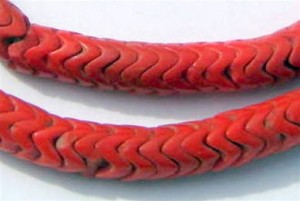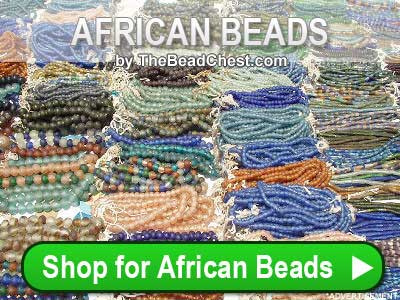Snake Beads have long been a fascinating variant of African trade bead for
jewelry artisans, and collectors. The simplicity of their inter-locking characteristic, coupled with the fascinating hues by which they are now produced have made them versatile for all kinds of modern jewelry – including African waist beads.
The African Snake Beads you see today, are largely reproductions, despite many traders still offering the original Bohemian variants, which can be up to 150 years old. These were made during the height of glass bead production within Czechoslovakia, and are still the most sought after types of Snake Beads on the market.
Czech glass Snake Beads were designed to replicate the actual snake vertebrae of a coiled serpent. Snake vertebrae were used by the indigenous tribes of South Africa for many thousands of years, prior to the capabilities for glass production, and were considered an amulet of protection to many.
Tribes such as the Asanti, Krobo and Yoruba have a significant naturalistic faith; to the extent that they believe spirits accommodate any element of the earth, be it living, mineral or dead. The snake bite tends to be considered a bad omen, particularly since many native African serpents are known to be deadly. The only method by which an individual can be cured of a poisonous bite (according to tribal belief), is if the perpetrating snake is killed; it’s poison mixed with a concoction of hot milk, and a certain bone found within the back of the serpent’s head thrown into the mixture. It is thought application of the bone and mixture to the bite would draw out the poisonous impurities, replacing them with a neutralized substance that would aid healing. Whether this actually worked is subject to speculation, however the Yoruba still wear natural snake vertebrae to discourage venomous attacks, by animals considered to be possessed by negative spirits.
Snake Beads proved to be considerably popular during the 19th Century trade movement between Africa and Europe. Czechoslovakia was fast catching up with Venetian production by this time, although recognized the cost-effective benefits of producing simpler beads with far less decorative attributes. Snake Beads were the obvious option, partly due to the nature of their characteristics, yet also because they were highly prized by the many tribes encountered, during trade trips to Africa. Despite the sliced aesthetic of Snake Beads, they were actually manufactured using the glass molding method – not dissimilar to the manner by which recycled glass beads are made in the Krobo today.
The 1960′s were a time of considerable revival for all manner of trade beads, as Africa began realizing the value of their carefully stashed antiques, and began exporting them in significant quantities. The increase of mass tourism to sub-Saharan areas also commenced a fascination with Snake Beads. The ‘hippie’ era of the late 60′s proved to be a particularly appreciative customer base, as the connecting beads were considered very Bohemian for styles of the time. Jim Morrison is alleged to have been a big fan, and wore a chain of Snake Beads in the Joel Brodsky ‘Young Lion’ photograph (1967).
Today, African Snake Beads are still evidently as popular among ‘Boho’ fashionistas as they were during the 1960′s, however their popularity has been further fueled by celebrity trends. The pop singer Rihanna was photographed in August 2010 upon the cover of ‘Seventeen’ magazine wearing a string of colored Snake Beads. The Snake Bead aesthetic has even borne a replica bead stitch known as ‘tubular Ndebele’, created by tribes within Zimbabwe to simulate the interlocking ‘one-ness’ of Snake Beads. As African and eco-fashions continue to dominate modern trends, it is likely we will be seeing far more of Snake Beads over the next few years.


 African beads, trade beads, and antique beads have been enjoyed by many for centuries. African beads are treasured for their history. Many have traveled over 3 continents and can be up to centuries old. This blog is devoted to providing you with accurate information on African beads, trade beads, and antique beads. We hope you enjoy our blog!
African beads, trade beads, and antique beads have been enjoyed by many for centuries. African beads are treasured for their history. Many have traveled over 3 continents and can be up to centuries old. This blog is devoted to providing you with accurate information on African beads, trade beads, and antique beads. We hope you enjoy our blog!